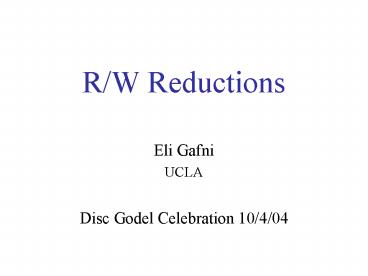RW Reductions - PowerPoint PPT Presentation
Title:
RW Reductions
Description:
SE with if pi elect pj then pj elects itself. TST(n-1,n) reducible to SE(n-1,n) ... If out(pi)=pi return win else lose. Reductions Cont'ed. TST(n-1,n) ... – PowerPoint PPT presentation
Number of Views:60
Avg rating:3.0/5.0
Title: RW Reductions
1
R/W Reductions
- Eli Gafni
- UCLA
- Disc Godel Celebration 10/4/04
2
Outline
- Tasks
- R/W reduction
- Weakest Unsolvable Task Thesis
- Reductions
- Conclusions/Speculations
3
Tasks
3-Procs Test-and-Set (TST) TST(1, 3) pi
(win) i0,1,2 pi,pj (win,lose),
(lose,win) i j pi,pj,pk (win,lose,lose),(lose
,win,lose), (lose,lose,win) i j
k Allowed output tuples for participating sets
4
Tasks Conted
UN(n,2n-2) Uniform renaming p0,,pn-1 out(pi)
1,,2n-2) 0ut(pi) out(pj) pi P, Pk out(pi) 1,,2k-1
5
R/W Reducibility Between Tasks
Task A r/w reducible to B
A
R/W
R/W
B
6
R/W reducibility Conted
(2,3) set-election task p0,p1,p2 One or two
procs elect themselves, the others elect an
elected proc. pi (pi) pi,pj (pi,pi),
(pj,pj), (pi,pj) pi,pj,pk (pi,pi,pi),(pi,pj,pi)
,(pi,pj,pj),
7
R/W reducibilty Contd
(2,3) set-election r/w reducible to 3-tst pi
cidi initially register vitst if
viwin then return pi else cilose () scan
if exists j s.t. djpi then return pi dipj
s.t. pj registered, cj scan if cj then
retrun pj else goto ()
8
R/W reducibility Conted
- Reducibilty induces a directed graph over tasks
- A strongly connected component are tasks which
are r/w equivalent - Wishful Weakest-Thesis
- There exist a task WEAKEST(n)
- WEAKEST(n) is r/w unsolvable.
- WEAKEST(n) is reducible to any task which is
unsolvable when restricted to participating set
of at most n procs.
9
R/W reducibility Conted
- If Weakest-Thesis hold then
- all Maurice can do, we can do better.
- Can think Java and not worry about not knowing
Basic. - Can go back to thinking distributed rather than
topology. - Plausibilty
- All known unsolvable tasks are reducible to
SB(n,2n-1) (Symmetry Breaking) - SB(n,2n-1) p0,,p2n-2
- procs output 0 or 1
- Pn not all 0s and not all 1s
10
Reductions
SB(n,2n-1) is unsolvable HS93
Comparison-Renaming CR(n,2n-2) is
unsolvable Ramsey-Theorem implies CR(n,2n-2)
unsolvable iff Renaming R(n,2n-1,2n-2)
unsolvable R(n,2n-1,2n-2) reducible to
SB(n,2n-1) Procs that output 0 Attiya et al
rename 1,2, Procs that output 1
2n-2,2n-3, Attiya et al k0 (!) rename into
2k-1 2n0-12n1-12n-2 if n0,n10
11
Reductions Conted
SB(n,2n-1) reducible to R(n,2n-1,2n-2) position
1,,n-1 output 0 position n,,2n-2 output 1
TST(n-1,n) p0,,pn-1 For all P at least one
proc returns win Number of wins at most n-1
SB(n,2n-1) reducible to TST(n-1,n) Use two
TSTs TST1 and TST2 procs p0,,pn-1 connected
to TST1 procs pn,,p2n-2
TST2 from TST1 win1 lose0 from TST2
win0 lose1
12
Reductions Conted
TST(n-1,n) reducible to SB(n,2n-1) I donot
think so! (As we heard SB(n,2n1) is a Torus
and Torus is a manifold and manifold
satisfies Sperner so no Torus van do real
2-set hole)
Currently
SB(n,2n-1)
TST(n-1,n)
R(n,2n-1,2n-2)
13
Reductions Conted
SE(n-1,n) Set Election for all P proc elect a
proc in P electedElection SE with if pi elect pj then pj elects
itself TST(n-1,n) reducible to
SE(n-1,n) SSE(n-1,n) equivalent to
SE(n-1,n) SSE(n-1,n) reducible to
SE(n-1,n) () cielected(pi), scan If
exits j st djpi then elect(pi)pi else
difollow arrows to end or max in
cycle scan, if cdi return di else
goto ()
14
Reductions Conted
SSE(n-1,n) reducible to TST(n-1,n) Same trick
as pointing to potential winner and
suggesting it elect itself. The first one to
announce lose will never elect
itself. TST(n-1,n) reducible to SSE(n-1,n) If
out(pi)pi return win else lose.
15
Reductions Conted
TST(n-1,n) reducible to UR(n,2n-2) If return
UR(n,2n-2)k2k-1-kk-1 16
Reductions Conted
UR(n,2n-2) reducible to TST(n-1,n) The BG93
algorithm for UR(n,2n-1) Rename(m,up) Take
Imm Snap ciSi if pi max id in Si return
(m-1)2Si-1 else Rename(2Si-2,down) Rena
me(m,down) Take Imm Snap ciSi if pi max id
in Si return (m1)(2Si-1) else
Rename(2Si,up)
17
Reductions Conted
Example 7,4 p7,p4 0,2,4,7,3
p0,p2,p3 6,0,2,4,7,3,5,1 p1,p6,p5 p7
returns 3, p4 rename from 2 down p0,p2,p3
rename from 25-28 down p1,p6,p5 rename from
28-214 down
p4 will rename at 2 later
8,7,6,5,4 is exactly enough for 3 procs
14,13,12,11,10 is exactly enough for 3 procs
18
Reductions Conted
Variant on the first phase of the
BG TST(n-1,n) Know how by helping
guarantee that the smallest returned imm snap
is all by winners if Si is all made of winners
and pi is max then return 2Si-1 else
Rename(2Si-2,down) if Si contain losers and
pi max among losers then return 2Si-2 else
Rename(2Si-3,down) There will be loser who
will drop off in the first phase from the
smallest snap that contains both winners and
losers.
19
Conclusions
TST(n-1,n)
SB(n,2n-1)
UR(n,2n-2)
R(n,2n-1,2n-2)
SE(n-1,n)
SSE(n-1,n)
20
Conclusion Conted
Challenge
Procs p1,p2,p3 q1,q2,q3 Uniform rename to 5
slots when pi and qi can share a
slot. Conjecture need 6. By Thesis there
should exist a reduction
More Exist min number of rounds for set
consensus for synchronous systems by r/w
reduction
Is all this relations a structure a fluke?































